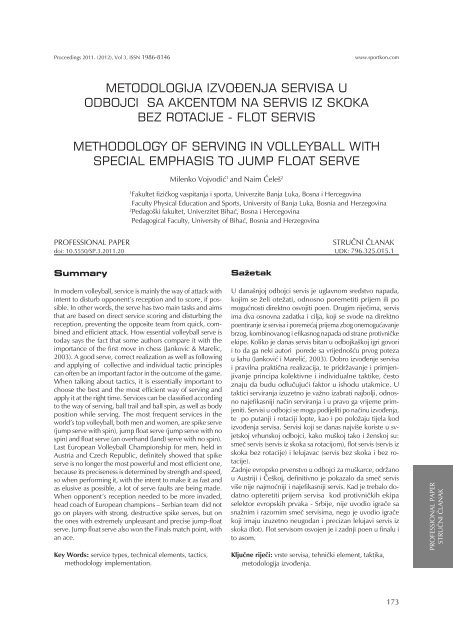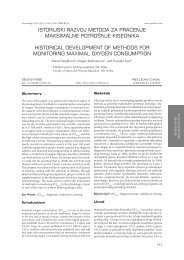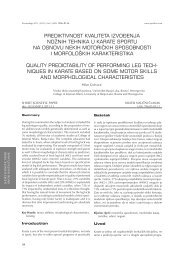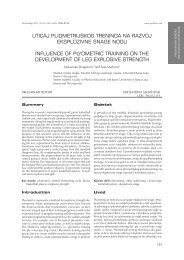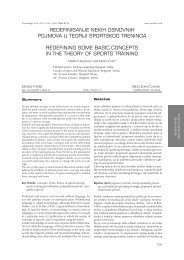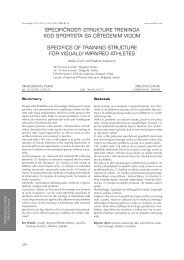metodologija izvoÄenja servisa u odbojci sa akcentom na servis iz ...
metodologija izvoÄenja servisa u odbojci sa akcentom na servis iz ...
metodologija izvoÄenja servisa u odbojci sa akcentom na servis iz ...
Create successful ePaper yourself
Turn your PDF publications into a flip-book with our unique Google optimized e-Paper software.
Proceedings 2011. (2012), Vol 3, ISSN 1986-8146www.sportkon.comMETODOLOGIJA IZVOÐENJA SERVISA UODBOJCI SA AKCENTOM NA SERVIS IZ SKOKABEZ ROTACIJE - FLOT SERVISMETHODOLOGY OF SERVING IN VOLLEYBALL WITHSPECIAL EMPHASIS TO JUMP FLOAT SERVEMilenko Vojvodi} 1 and Naim ]ele{ 21Fakultet f<strong>iz</strong>ičkog vaspitanja i sporta, Univerzite Banja Luka, Bos<strong>na</strong> i Hercegovi<strong>na</strong>Faculty Physical Education and Sports, University of Banja Luka, Bosnia and Herzegovi<strong>na</strong>2Pedago{ki fakultet, Univerzitet Biha}, Bos<strong>na</strong> i Hercegovi<strong>na</strong>Pedagogical Faculty, University of Biha}, Bosnia and Herzegovi<strong>na</strong>PROFESSIONAL PAPERSTRUČNI ČLANAKdoi: 10.5550/SP.3.2011.20 UDK: 796.325.015.1SummarySažetakIn modern volleyball, service is mainly the way of attack withintent to disturb opponent’s reception and to score, if possible.In other words, the serve has two main tasks and aimsthat are based on direct service scoring and disturbing thereception, preventing the opposite team from quick, combinedand efficient attack. How essential volleyball serve istoday <strong>sa</strong>ys the fact that some authors compare it with theimportance of the first move in chess (Jankovic & Marelic,2003). A good serve, correct real<strong>iz</strong>ation as well as followingand applying of collective and individual tactic principlescan often be an important factor in the outcome of the game.When talking about tactics, it is essentially important tochoose the best and the most efficient way of serving andapply it at the right time. Services can be classified accordingto the way of serving, ball trail and ball spin, as well as bodyposition while serving. The most frequent services in theworld’s top volleyball, both men and women, are spike serve(jump serve with spin), jump float serve (jump serve with nospin) and float serve (an overhand (land) serve with no spin).Last European Volleyball Championship for men, held inAustria and Czech Republic, definitely showed that spikeserve is no longer the most powerful and most efficient one,because its preciseness is determined by strength and speed,so when performing it, with the intent to make it as fast andas elusive as possible, a lot of serve faults are being made.When opponent’s reception needed to be more invaded,head coach of European champions – Serbian team did notgo on players with strong, destructive spike serves, but onthe ones with extremely unplea<strong>sa</strong>nt and precise jump-floatserve. Jump float serve also won the Fi<strong>na</strong>ls match point, withan ace.Key Words: service types, technical elements, tactics,methodology implementation.U da<strong>na</strong>{njoj <strong>odbojci</strong> <strong>servis</strong> je uglavnom sredstvo <strong>na</strong>pada,kojim se želi otežati, odnosno poremetiti prijem ili pomogućnosti direktno osvojiti poen. Drugim riječima, <strong>servis</strong>ima dva osnov<strong>na</strong> zadatka i cilja, koji se svode <strong>na</strong> direktnopoentiranje <strong>iz</strong> <strong>servi<strong>sa</strong></strong> i poremećaj prijema zbog onemogućavanjebrzog, kombinovanog i efikasnog <strong>na</strong>pada od strane protivničkeekipe. Koliko je da<strong>na</strong>s <strong>servis</strong> bitan u odbojka{koj igri govorii to da ga neki autori porede <strong>sa</strong> vrijedno{ću prvog potezau {ahu (Janković i Marelić, 2003). Dobro <strong>iz</strong>vođenje <strong>servi<strong>sa</strong></strong>i pravil<strong>na</strong> praktič<strong>na</strong> real<strong>iz</strong>acija, te pridržavanje i primjenjivanjeprincipa kolektivne i individualne taktike, čestoz<strong>na</strong>ju da budu odlučujući faktor u ishodu utakmice. Utaktici serviranja <strong>iz</strong>uzetno je važno <strong>iz</strong>abrati <strong>na</strong>jbolji, odnosno<strong>na</strong>jefikasniji <strong>na</strong>čin serviranja i u pravo ga vrijeme primjeniti.Servisi u <strong>odbojci</strong> se mogu podijeliti po <strong>na</strong>činu <strong>iz</strong>vođenja,te po putanji i rotaciji lopte, kao i po položaju tijela kod<strong>iz</strong>vođenja <strong>servi<strong>sa</strong></strong>. Servisi koji se da<strong>na</strong>s <strong>na</strong>jvi{e koriste u svjetskojvrhunskoj <strong>odbojci</strong>, kako mu{koj tako i ženskoj su:smeč <strong>servis</strong> (<strong>servis</strong> <strong>iz</strong> skoka <strong>sa</strong> rotacijom), flot <strong>servis</strong> (<strong>servis</strong> <strong>iz</strong>skoka bez rotacije) i lelujavac (<strong>servis</strong> bez skoka i bez rotacije).Zadnje evropsko prvenstvo u <strong>odbojci</strong> za mu{karce, održanou Austriji i Če{koj, definitivno je pokazalo da smeč <strong>servis</strong>vi{e nije <strong>na</strong>jmoćniji i <strong>na</strong>jefikasniji <strong>servis</strong>. Kad je trebalo dodatnoopteretiti prijem <strong>servi<strong>sa</strong></strong> kod protivničkih ekipaselektor evropskih prvaka - Srbije, nije uvodio igrače <strong>sa</strong>s<strong>na</strong>žnim i razornim smeč <strong>servis</strong>ima, nego je uvodio igračekoji imaju <strong>iz</strong>uzetno neugodan i prec<strong>iz</strong>an lelujavi <strong>servis</strong> <strong>iz</strong>skoka (flot). Flot <strong>servis</strong>om osvojen je i zadnji poen u fi<strong>na</strong>lu ito asom.Ključne riječi: vrste <strong>servi<strong>sa</strong></strong>, tehnički element, taktika,<strong>metodologija</strong> <strong>iz</strong>vođenja.PROFESSIONAL PAPERSTRUČNI ČLANAK173
Vojvodi}, M., & ]ele{, N.: METHODOLOGY OF SERVING IN VOLLEYBALL... Proceedings 2011, 173–182IntroductionUvodPROFESSIONAL PAPERSTRUČNI ČLANAKService is a technical element of volleyball and representsthe beginning kickoff that is performed at the start of the setand after each mistake. It is a technical element whoseperformance begins at the struggle for points, and is deliveredby the player occupying the number one position behindthe baseline. It is one of the most important elements ofvolleyball and therefore requires special attention andplenty of training time at each training session. (Selinger2000). Tomic has recommended that service training shouldbe linked with other elements such as reception, organ<strong>iz</strong>ingof attacks, organ<strong>iz</strong>ing of specific roles for players and so on.It is not recommendable to practice service separate fromother elements. Each type of service has its advantages anddi<strong>sa</strong>dvantages (Tomic, 1976, p. 146). Service delivery ca<strong>na</strong>lso be very stressful, especially during crucial points. That’sbecause all the attention of players, coaches, audience andenvironment are focused on the player delivering the serve.Good service and proper practical implementation oftentend to be the decisive factor in the outcome of the match.In the tactics of serving it is extremely important to choosethe best and most efficient way of serving, and the right timeto apply it as well.According to the manner of delivery we can distinguishseveral types of services including: lower frontal service,overhead (upper) service, frontal jump service and sideservice, while in relation to the rotation of the ball, theservice can be with rotation and without rotation of theball.Today, in world-class volleyball, men’s as well as women’s,services that are exclusively applied are:• wall head-on service from the jump with ball rotation- Spike Service• wall head-on service from the jump without ball rotation- Float Service• upper butt out of service without ball rotation –FloaterWhen it comes to the speed of the ball during the serve,the highest possible speed is accomplished by setter serviceand it is approximately 120 km / h, or about 33 m / s. Duringthe well performed setter service, roughly the speed i<strong>sa</strong>bout 100 km / h or 28 m / s. Usually, the speed of the ballduring the service is approximately 15 m / s. It is establishedthat receiving players’ reaction time is 0.3 seconds, and thatduring the service with maximum ball speed, the ball travel<strong>sa</strong>bout 0.5 seconds from the moment it is struck to the timeof receipt. That means that this service is virtually uncatchable.During a well executed service, time travel of the ballis 0.7 seconds. This amount of time e<strong>na</strong>bles the receipt ofservice if the ball, in the moment of reception by the receivingplayer, doesn’t require any leg movement (Selinger 2000).During a normal ball speed service, the ball travels for aboutone second. This time is sufficient for the service receiver toposition himself well and to pass the ball to the setter. Ofcourse, this is not always the case, but a good effect can beachieved with this ball speed provided that the receivingplayers are not ready, and the server hits the right spot atthe right time.Service as anelement of the gameServis je tehnički eleme<strong>na</strong>t odbojka{ke igre i predstavljapočetni udarac koji se <strong>iz</strong>vodi <strong>na</strong> početku seta i poslije svakegre{ke, odnosno tehnički element čijim <strong>iz</strong>vođenjem počinjeborba za poen, a <strong>iz</strong>vodi ga igrač koji se <strong>na</strong>lazi u poziciji jedan<strong>iz</strong>a osnovne linije. On predstavlja jedan od <strong>na</strong>jbitnijih eleme<strong>na</strong>taodbojka{ke igre i zato mu treba posvetiti velikupažnju i dovoljno vreme<strong>na</strong> <strong>na</strong> svakom treningu. (Selinger2000). Tomić je preporučio da uvježbavanje <strong>servi<strong>sa</strong></strong> trebapovezivati <strong>sa</strong> drugim elementima kao {to su primanje <strong>servi<strong>sa</strong></strong>,organ<strong>iz</strong>ovanje <strong>na</strong>pada, organ<strong>iz</strong>ovanje pojedinih specifičnihuloga igrača i td. Nije dobro uvježbavati <strong>servis</strong> <strong>iz</strong>dvojen odostalih eleme<strong>na</strong>ta. Svaka vrsta <strong>servi<strong>sa</strong></strong> ima svoje prednosti inedostatke (Tomić, 1976, str. 146). Izvođenje <strong>servi<strong>sa</strong></strong> možeda bude i veoma stresno, pogotovo kod odlučujućih poe<strong>na</strong>.To je zbog toga {to je sva pažnja igrača, trenera, publike iokoline usredsređe<strong>na</strong> <strong>na</strong> igrača koji je <strong>na</strong> <strong>servis</strong>u. Dobro<strong>iz</strong>vođenje <strong>servi<strong>sa</strong></strong> i pravil<strong>na</strong> praktič<strong>na</strong> real<strong>iz</strong>acija, čestoz<strong>na</strong>ju da budu odlučujući faktor u ishodu utakmice. U takticiserviranja <strong>iz</strong>uzetno je važno <strong>iz</strong>abrati <strong>na</strong>jbolji, odnosno<strong>na</strong>jefikasniji <strong>na</strong>čin serviranja i u pravo ga vrijeme primjeniti.Prema <strong>na</strong>činu <strong>iz</strong>vođenja možemo razlikovati nekoliko vrsta<strong>servi<strong>sa</strong></strong> i to: donji čeoni <strong>servis</strong>, gornji čeoni <strong>servis</strong>, gornji čeoni<strong>servis</strong> <strong>iz</strong> skoka i bočni <strong>servis</strong>, a u odnosu <strong>na</strong> rotaciju lopte,<strong>servis</strong> u <strong>odbojci</strong> može biti <strong>sa</strong> rotacijom i bez rotacije lopte.Da<strong>na</strong>s se u vrhunskoj <strong>odbojci</strong> <strong>odbojci</strong>, kako mu{koj tako iženskoj, koriste isključivo ovi <strong>servis</strong>i:• gornji čeoni <strong>servis</strong> <strong>iz</strong> skoka <strong>sa</strong> rotacijom lopte - smeč<strong>servis</strong>• gornji čeoni <strong>servis</strong> <strong>iz</strong> skoka bez rotacije lopte - flot<strong>servis</strong>• gornji čeoni <strong>servis</strong> <strong>iz</strong> mjesta i bez rotacije lopte - lelujavi<strong>servis</strong>Kad je u pitanju brzi<strong>na</strong> kretanja lopte kod serviranja, <strong>na</strong>jvećamoguća brzi<strong>na</strong> lopte postiže se <strong>iz</strong>vođenjem smeč <strong>servi<strong>sa</strong></strong> io<strong>na</strong> približno <strong>iz</strong>nosi otprilike do 120 km/h , odnosno približno33 m/s. Prilikom odlično <strong>iz</strong>vedenog smeč <strong>servi<strong>sa</strong></strong>, brzi<strong>na</strong>lopte približno <strong>iz</strong>nosi oko 100 km/h ili 28 m/s. Najče{ća,odnosno uobičaje<strong>na</strong>, brzi<strong>na</strong> lopte prilikom serviranja približno<strong>iz</strong>nosi oko 15 m/s. Ustanovljeno je da vrijeme reagovanjaprimača <strong>iz</strong>nosi 0,3 sekunde, a da kod <strong>servi<strong>sa</strong></strong> <strong>iz</strong>vedenogmaksimalnom brzinom kretanja lopte, o<strong>na</strong> od momentaudarca do momenta prijema putuje oko 0,5 sekundi. Toz<strong>na</strong>či da je ovakav <strong>servis</strong> praktično neuhvatljiv. Prilikomodlično <strong>iz</strong>vedenog smeč <strong>servi<strong>sa</strong></strong> vrijeme leta lopte je 0,7sekundi, tako da ovo vrijeme omogućuje <strong>iz</strong>vođenje prijema<strong>servi<strong>sa</strong></strong> ukoliko lopta u momentu prijema od primača nezahtijeva pomjeranje nogama (Selinger 2000).Kod <strong>servi<strong>sa</strong></strong> <strong>iz</strong>vedenog uobičajenom brzinom lopte vrijemeleta lopte je oko jedne sekunde. Ovo vrijeme je dovoljnoda se primač <strong>servi<strong>sa</strong></strong> postavi <strong>na</strong> loptu i kvalitetno je dodad<strong>iz</strong>aču. Naravno, to nije uvijek tako, pa se dobar efekatpostiže i <strong>servis</strong>ima <strong>sa</strong> ovakvom brzinom lopte, pod uslovomda primači nisu dovoljno spremni, a server pogodi pravomjesto u pravom trenutku.Servis kaoelement igreThe service was created when volleyball was created, a<strong>sa</strong> way to throw the ball in play, that is to serve the ball to174Servis je <strong>na</strong>stao kada i odbojka, kao <strong>na</strong>čin da se loptaubaci u igru, odnosno da se lopta servira protivniku. U vrijeme<strong>na</strong>stajanja odbojke <strong>servis</strong> je predstavljao <strong>sa</strong>mo početak igre
Vojvodi}, M., & ]ele{, N.: METHODOLOGY OF SERVING IN VOLLEYBALL... Proceedings 2011, 173–182abilities, among other things, character<strong>iz</strong>e him as a player.We are reminded that spike service came from beach volleyballand is mostly used and perfected by Brazilians. Itshould be <strong>sa</strong>id that the spike service in today’s world-classmen’s volleyball is the most widely used service, unlikewomen’s volleyball where the float service is most important,and all other types of service are only used as an alter<strong>na</strong>tive.There are players who do not use the spike service, but ifthey perform the float service well, there are no shortcomingsin their game.The best combi<strong>na</strong>tion of tactics in individual servings in topmen’s volleyball is that the basic service is – the spike service,and the alter<strong>na</strong>tive - float service. This is because the spikeservice must be received by at least three nearby player<strong>sa</strong>nd because the preparatory work for the spike and floatma<strong>na</strong>gement service are similar, so the opponent has toprepare for this first one. This situation provides an opportunityto place the float service in the desired manner withgood effect, and to take your opponents by surprise. However,slower, or insufficiently aggressive and quick spikeservice is very easy to receive, so according to many, it isbetter to perform a good and precise float, rather than reducingthe speed and power of a spike service.Individual tactics service (Kostic & Kalajdžić, 1995) can bereduced to the following tasks and objectives:•to score a point•to make it harder for opponents to organ<strong>iz</strong>e faster andmore diverse attacks•to prevent mistakes in the delivery of servicePart of the skill of individual servings are situations where aplayer should not make a mistake, and this applies to thefollowing situations:•start of the game•after time-out•after an error of the teammate who previously served•after their own faults in previous servings•when the opponent is in a negative series of points•after a change which strengthens the block of one’steam•after a long and difficult changeIndividual serving’s tactic involves many other things that aplayer can do in order to gain any advantage over opponents.This advantage can be achieved by changing the rhythm,method, and frequency of the service. In addition to individualand collective tactics of serving, attention should befocused on the more challenging tasks, which are consideredas both collective and individual tactics.Methodologyof service deliverysobnosti, pored ostalog, karakteri{u kao igrača. Možemo sepodsjetiti da je smeč <strong>servis</strong> u pravu odbojku do{ao <strong>iz</strong> odbojke<strong>na</strong> plaži i da su ga Brazilci <strong>na</strong>jvi{e koristili a i u<strong>sa</strong>vr{avali.Treba reći da je smeč <strong>servis</strong> u da<strong>na</strong>{njoj mu{koj vrhunskoj<strong>odbojci</strong> <strong>na</strong>jče{ći i <strong>na</strong>jvi{e kori{teni <strong>servis</strong>, za razliku od ženskegdje je flot <strong>servis</strong> prvi po važnosti, a da su sve ostale vrste<strong>servi<strong>sa</strong></strong> <strong>sa</strong>mo alter<strong>na</strong>tiva. Ima igrača koji ne koriste smeč<strong>servis</strong> , ali ako dobro <strong>iz</strong>vode flot <strong>servis</strong> u njihovoj igri se neosjeća nedostatak.Najbolja kombi<strong>na</strong>cija u individualnoj taktici serviranja umu{koj vrhunskoj <strong>odbojci</strong> je da je osnovni <strong>servis</strong> - smeč<strong>servis</strong>, a alter<strong>na</strong>tiva - flot <strong>servis</strong>. To je zato {to se smeč <strong>servis</strong>mora primati <strong>sa</strong> <strong>na</strong>jmanje tri primača i zato {to su pripremneradnje za smeč i flot <strong>servis</strong> slične, pa se protivnik mora pripremit<strong>iz</strong>a ovaj prvi. Ta situacija pruža mogućnost da se flot<strong>servis</strong> plasira <strong>na</strong> željeni <strong>na</strong>čin <strong>sa</strong> dobrim učinkom i protivničkaekipa <strong>iz</strong>ne<strong>na</strong>di. Međutim, sporiji, odnosno nedovoljnoagresivan i brz smeč <strong>servis</strong> veoma je lagan za prijem, pa jepo mnogima bolje <strong>iz</strong>vesti dobar i prec<strong>iz</strong>an flot, nego smanjivatibrzinu i s<strong>na</strong>gu smeč <strong>servi<strong>sa</strong></strong>.Individual<strong>na</strong> taktika <strong>servi<strong>sa</strong></strong> (Kostić i Kalajdžić, 1995) se možesvesti <strong>na</strong> sledeće zadatke, odnosno ciljeve:• da se postigne poen• da se oteža mogućnost brzog i raznovrsnog <strong>na</strong>padaprotivnika• da se ne pogrije{i kod <strong>iz</strong>vođenja <strong>servi<strong>sa</strong></strong>Dio individualne taktike serviranja su situacije kada igrač nebi smio da <strong>na</strong>pravi gre{ku, a to se odnosi <strong>na</strong> sledeće situacije:•početak igre•poslije tajm-auta•poslije gre{ke <strong>sa</strong>igrača koji je prethodno servirao•poslije sopstvene <strong>servis</strong> gre{ke kod prethodnog serviranja•kada je protivnik u negativnoj seriji poe<strong>na</strong>•poslije <strong>iz</strong>mjene kojom se pojačava blok svoje ekipe•poslije duge i te{ke promjeneIndividual<strong>na</strong> taktika serviranja obuhvata i mnoge druge stvarikoje igrač može raditi <strong>sa</strong> ciljem da stekne bilo kakvu prednostu odnosu <strong>na</strong> protivnika. Ta prednost se može postići promjenomritma, <strong>na</strong>či<strong>na</strong>, kao i frekvencije <strong>iz</strong>vođenja <strong>servi<strong>sa</strong></strong>.Pored individualne i kolektivne taktike kod serviranja, pažnjatreba da bude usmjere<strong>na</strong> <strong>na</strong> vi{e zadataka koji se postavljajui kao kolektiv<strong>na</strong> i kao individual<strong>na</strong> taktika.Metodologija<strong>iz</strong>vođenja <strong>servi<strong>sa</strong></strong>PROFESSIONAL PAPERSTRUČNI ČLANAKSpike serviceSpike service is one of the most difficult elements of thegame of volleyball because its implementation requires,among other things:•a precise drop ball•precise and powerful momentum•a strong high jump and long jump•a kick with great force and speed•landingA service begins with a proper delivery position, and endswhen the player positions himself in the starting defenseposition. All these activities individually, but especially as aSmeč <strong>servis</strong>Smeč <strong>servis</strong> je jedan od <strong>na</strong>jtežih eleme<strong>na</strong>ta odbojka{ke igrezato {to njegovo <strong>iz</strong>vođenje <strong>iz</strong>među ostalog zahtijeva i:•prec<strong>iz</strong>no podbacivanje lopte•prec<strong>iz</strong>an i s<strong>na</strong>žan zalet•s<strong>na</strong>žan skok u vis i dalj• udarac velikom s<strong>na</strong>gom i brzinom•doskokServis se započinje pravilnim stavom za <strong>iz</strong>vođenje, a zavr{avaodlaskom igrača u početnu poziciju za odbranu. Sve oveaktivnosti pojedi<strong>na</strong>čno, a posebno kao cjeli<strong>na</strong>, <strong>iz</strong>iskuju176
Vojvodi}, M. i ]ele{, N.: METODOLOGIJA IZVO\ENJA SERVISA U ODBOJCI... Zbornik radova 2011, 173–182whole, require a major effort by the server. This service is akiller if the ball speed is great, but this requires a lot of energy.The spike service delivered with low ball speed is veryeasy to receive, so it makes no sense to deliver it that way.Advice that is given to players in matches and trainings inthe delivery of the spike is to avoid contact with the ball inthe downward phase of the jump, that is to use the firstphase when the speed of the server is greatest and is on therise. With young players performing the spike service, weshould insist that the ball speed is such that it does notjeopard<strong>iz</strong>e the <strong>sa</strong>fety of the service. Ball speed should beincreased, almost imperceptibly, as progress in service deliveryis achieved.The ball should be thrown so that the server makes contactwith the ball two feet from the base line (toward the net),and jumps out as deeply as possible in the field (2 to 3meters). Server player tosses the ball about three feet in frontof himself, and about four feet upwards. At ejection, the ballmust and should have front rotation, so that the server caneasily kick the ball with a “spin” (Apricot & Jankovic, 1996).Service without jump and without rotation (Float)This service belongs to the group of services rendered frontallywithout a jump, and appeared after the side servicewithout a jump and without ball rotation (the Japaneseservice). Because of easier implementation and faster techniquelearning it has become increasingly widespread. Inrecent years it is used less than services performed from thejump, because they have a much shorter travel time of theball and are more efficient. Float is more often used inwomen’s volleyball in lower skill categories, where it’s oftenused as a basic service, while top players usually use it as a<strong>na</strong>lter<strong>na</strong>tive. It is done in a way that the server is facing thenet, with one foot sticking out front (left foot for the righthanded and right foot for the left handed), while the ball isnot ejected by more than one meter in height. The handthat is performing the service right before the jump ball goesin the back swing and the wrist is placed in a straight extensionof the forearm, solid and fixed. The ball is strongly hitin the center by the root of the hand, and moves withoutany rotation. This provides the floating effect due to the lossof speed at which the ball is moving, which depends onincreased air resistance (Selinger, 2000).The trajectory of the ball is almost a hor<strong>iz</strong>ontal line, and thegreater the hor<strong>iz</strong>ontal velocity of the ball, the greater is theeffect of swinging. Therefore, it is recommended that duringthe delivery of the float service, the player moves away fromthe main line at least six meters. Particularly, the effect ofthe wavy service is based on an undetermined path andchange of ball direction, resulting in difficult service reception(Kostic, 1999).Service from the jumpwithout rotation (Float service)Well trained float service represents the possibility of servingwithout the risk of errors. This service can, quite literally, hitany part of the opponent’s court with a relatively shorttravel time of the ball and very low percentage of error.These circumstances provide an opportunity for the implementationof many tactical ideas. The efficiency of thisservice is much greater when used as an alter<strong>na</strong>tive to spikeservice, especially if you can hide it and perform it well.According to phases of the throws, the spike and float serviceare somewhat similar. Specifically, in both types of servicewe have a running phase, a drop ball, a jump phase, kickveoma veliki <strong>na</strong>por od strane servera. Ovaj <strong>servis</strong> je ubojitako je brzi<strong>na</strong> lopte velika, a upravo to zahtijeva veliku uloženuenergiju. Smeč <strong>servis</strong> <strong>iz</strong>veden <strong>sa</strong> malom brzinom lopte jeveoma lak za prijem i nema smisla tako ga <strong>iz</strong>voditi.Savjet koji se <strong>na</strong>jče{će daje igračima <strong>na</strong> utakmicama itreninzima kod <strong>iz</strong>vođenja smeč <strong>servi<strong>sa</strong></strong> je da se <strong>iz</strong>bjegnekontakt <strong>sa</strong> loptom u silaznoj fazi skoka, odnosno da se iskoristiprva faza kada je brzi<strong>na</strong> servera uzlaz<strong>na</strong> i <strong>na</strong>jveća.Kod mladih igrača treba zahtijevati da prilikom <strong>iz</strong>vođenjasmeč <strong>servi<strong>sa</strong></strong> brzi<strong>na</strong> lopte bude takva da ne ugrožava sigurnost<strong>iz</strong>vođenja <strong>servi<strong>sa</strong></strong>. Sa <strong>na</strong>predovanjem u u<strong>sa</strong>vr{avanju<strong>servi<strong>sa</strong></strong>, skoro neprimjetno, brzinu lopte treba povećavati.Loptu treba podbaciti tako da ko<strong>na</strong>kt <strong>sa</strong> njom server započnepola metra od osnovne linije (prema mreži), a skok <strong>iz</strong>vede{to je moguće dublje u teren (2 do 3 metra). Server podbacujeloptu oko tri metra ispred sebe, a oko četiri uvis. Kod<strong>iz</strong>bačaja, lopta mora i treba da ima prednju rotaciju, kakobi server lak{e <strong>iz</strong>veo udarac po lopti <strong>sa</strong> “spinom” (Marelić iJanković, 1996)Najče{će gre{ke koje se mogu javiti kod <strong>iz</strong>vođenja smeč<strong>servi<strong>sa</strong></strong> su lo{ ili neadekvatan <strong>iz</strong>bačaj lopte, zatim nepravilankontakt dla<strong>na</strong> i lopte , te nepravilan zalet i skok .Lelujavac (<strong>servis</strong> bez skoka i bez rotacije)Pripada grupi <strong>servi<strong>sa</strong></strong> <strong>iz</strong>vedenih čeono bez skoka, a pojaviose <strong>na</strong>kon bočnog <strong>servi<strong>sa</strong></strong> bez skoka i bez rotacije lopte (japanski<strong>servis</strong>). Zbog lak{eg <strong>iz</strong>vođenja i lak{eg usvajanja tehnikepostao je veoma rasprostranjen. U novije vrijeme potisnutje <strong>servis</strong>ima koji se <strong>iz</strong>vode <strong>iz</strong> skoka zato {to imaju dalekokraće vrijeme leta lopte i daleko su efikasniji. Lelujavi <strong>servis</strong>(lelujavac) če{će se koristi u ženskoj <strong>odbojci</strong> i kod nižihkategorija obučenosti, gdje ga <strong>na</strong>jče{će koriste kao osnovni<strong>servis</strong>, dok kod vrhunskih igrača <strong>na</strong>jče{će predstavlja alter<strong>na</strong>tivu.Izvodi se <strong>na</strong> <strong>na</strong>čin da server bude okrenut licemprema mreži, <strong>sa</strong> jednom nogom isturenom <strong>na</strong>prijed (de{njacilijevu, a ljevaci desnu), a lopta se ne <strong>iz</strong>bacuje vi{e od jednodmetra u visinu. Ruka kojom se <strong>iz</strong>vodi <strong>servis</strong> treba daneposredno prije podbacivanja ide u zamah u<strong>na</strong>zad, a zglob{ake je postavljen ravno u produžetku podlaktice, čvrst ifiksiran. Lopta se energično udara korjenom {ake u njencentar, a kreće se bez ikakve rotacije. Time se postiže lelujajućiefekat zbog gubljenja brzine kojom se kreće lopta, a koja jeu zavisnosti od povećanja otpora vazduha (Selinger, 2000).Putanja leta lopte je skoro hor<strong>iz</strong>ontal<strong>na</strong> linija i {to je hor<strong>iz</strong>ontal<strong>na</strong>brzi<strong>na</strong> lopte veća, to je efekat lelujanja veći. Zatose preporučuje, da se kod serviranja lelujavog <strong>servi<strong>sa</strong></strong> odmakneod osnovne linije <strong>na</strong>jmanje {est metara. Naime, dejstvo lelujavih<strong>servi<strong>sa</strong></strong> se temelji <strong>na</strong> neutvrđenoj putanji i promjenipravca leta lopte, čime se postiže otežan prijem <strong>servi<strong>sa</strong></strong>(Kostić, 1999).Servis <strong>iz</strong> skokabez rotacije (Flot <strong>servis</strong>)Dobro uvježban predstavlja mogućnost serviranja bez r<strong>iz</strong>ikaod gre{ke. Ovim <strong>servis</strong>om se, bukvalno, može pogoditisvaki dio protivničkog tere<strong>na</strong> <strong>sa</strong> relativno kratkim vremenomleta lopte i veoma malim procentom gre{ke. Ove okolnostipružaju priliku za real<strong>iz</strong>aciju mnogih taktičkih zamisli. Efikasnostovog <strong>servi<strong>sa</strong></strong> je z<strong>na</strong>tno veća ako se upotrebljava kaoalter<strong>na</strong>tiva smeč <strong>servis</strong>u, <strong>na</strong>ročito ako se dobro prikrije idobro <strong>iz</strong>vede.Po fazama <strong>iz</strong>vođenja flot i smeč <strong>servis</strong> su donekle slični.Naime, i kod jednog i kod drugog <strong>servi<strong>sa</strong></strong> imamo faze zaleta,podbacivanja lopte, skoka, udarca po lopti i doskoka.PROFESSIONAL PAPERSTRUČNI ČLANAK177
Vojvodi}, M., & ]ele{, N.: METHODOLOGY OF SERVING IN VOLLEYBALL... Proceedings 2011, 173–182the ball phase and landing. However, each of these servicephases is different from the <strong>sa</strong>me phase of the other service.The main difference is that in the float service the ball travelswithout rotation, and in the spike service with rotation.Furthermore, the difference in these services are reflectedin the strength and speed of running and hitting the ball,strength and jump height, location where the ball is hit, andpart of the palm which is hitting the ball.Delivery of this service requires far less energy than aspike because the run-up, jump and kick are of far lesserintensity. Ball speed is much lower, but it can hit a placethat requires a significant movement of the receiving player,which significantly increases performance.It is essential for the float service to perform the jumpas much as possible in the depth of the field court, to“carry over” the ball to the serving hand and to perform andfinish the strike in the first phase of the jump. In this way,the movement and server speed are fully used.During the service execution ball travels with the server,which means that it has his speed of movement. The kickitself is adding speed to the ball at the moment when thevertical component of its speed equals zero. Therefore involleyball jargon we use the term ‘’ carrying out ‘’, and notthrowing the ball, because this ball is essentially carried outto the serving hand.The ball is hit at the very root of the palm center and thu<strong>sa</strong>voids rotation, increases speed, reduces the parabola ofthe ball, or the elevation angle, which is why it can get anunpredictable path, or undulation and “dancing.” What willbe the extent of the “floating” amplitude, depends on thestroke power, the s<strong>iz</strong>e of the ball deformation, pressure inthe ball, distance of servers from the baseline, the s<strong>iz</strong>e ofelevation angle, server’s impact height, gravity and air resistance(Stojanovic, Kostic, & Nesic, 2010, p. 61).Figures 1 and 2 shows the position of hands and palms,which are striking the ball, including the place the ball iskicked.Slika 1: Položaj dla<strong>na</strong> i mjesto udarca po loptiFigure 1: Position of the palm and place where the ball iskickedMeđutim, svaka od ovih faza jednog <strong>servi<strong>sa</strong></strong> različita je odiste faze drugog, a osnov<strong>na</strong> razlika je {to kod flot <strong>servi<strong>sa</strong></strong>lopta putuje bez rotacije, a kod smeč <strong>servi<strong>sa</strong></strong> <strong>sa</strong> rotacijom.Dalje, razlika kod ovih <strong>servi<strong>sa</strong></strong> se očituje jo{ u s<strong>na</strong>zi i brzin<strong>iz</strong>aleta i udarca po lopti, s<strong>na</strong>zi i visini skoka, kao i mjestuudarca po lopti, te dijelu dla<strong>na</strong> kojim se udara po lopti.Izvođenje ovog <strong>servi<strong>sa</strong></strong> zahtijeva daleko manje energije odsmeč <strong>servi<strong>sa</strong></strong> jer su zalet, skok i udarac daleko manjeg intenziteta.Brzi<strong>na</strong> lopte je z<strong>na</strong>tno manja, ali se može pogoditimjesto koje zahtijeva z<strong>na</strong>čajno pomjeranje primača,čime se uči<strong>na</strong>k bitno povećava.Su{ti<strong>na</strong> flot <strong>servi<strong>sa</strong></strong> je u tome da skok bude <strong>iz</strong>veden {to jemoguće vi{e u dubinu tere<strong>na</strong> i da se “<strong>iz</strong>no{enje” lopte predruku za serviranje i <strong>sa</strong>m udarac <strong>iz</strong>vedu i zavr{e u prvoj faziskoka. Na ovaj <strong>na</strong>čin se u cjelosti koristi kretanje odnosnobrzi<strong>na</strong> servera. Pri <strong>iz</strong>vođenju <strong>servi<strong>sa</strong></strong> lopta putuje <strong>sa</strong> serverom,{to z<strong>na</strong>či da ima njegovu brzinu kretanja. Sam udarac jedodavanje brzine lopti u trenutku kada je vertikal<strong>na</strong> komponentanjene brzine rav<strong>na</strong> nuli. Zbog toga se u odbojka{komžargonu koristi <strong>iz</strong>raz „<strong>iz</strong>no{enje“ lopte, a ne podbacivanje,jer se o<strong>na</strong> u su{tini <strong>iz</strong>nosi pred ruku kojom se servira. Loptase udara korijenom dla<strong>na</strong> u <strong>sa</strong>mi centar i <strong>na</strong> taj <strong>na</strong>čin <strong>iz</strong>bjegavarotacija, povećava ubrzanje, smanjuje parabola letalopte,odnosno elevacioni ugao, zbog čega se može dobitinepredvidljiva putanja, odnosno lelujanje i „ ple<strong>sa</strong>nje“. Kolikeće biti amplitude „lelujanja“ zavisi od: s<strong>na</strong>ge udarca,veličine deformacije lopte, pritiska u lopti, udaljenosti serveraod osnovne linije, veličine elevacionog ugla, udarnevisine servera, sile zemljine teže i otpora vazduha (Stojanović,Kostić i Ne{ić, 2010, str. 61).Slike 1 i 2 pokazuju položaj ruke, odnosno dla<strong>na</strong> kojim seudara po lopti, kao i mjesto udarca po lopti.Slika 2: Položaj i povr{i<strong>na</strong> dla<strong>na</strong> kod udarcaFigure 2: Position of the palm and surface at kickPROFESSIONAL PAPERSTRUČNI ČLANAKLast European Volleyball Championship for men, held inAustria and the Czech Republic, has definitely shown thatspike service is no longer the most powerful and most efficientservice. When we needed to additio<strong>na</strong>lly burden the servicereception of other teams, the coach of European champions-Serbia-did not introduce players with a powerful and devastatingspike service, but chose players who have an extremelyunplea<strong>sa</strong>nt and accurate floater from the jump (float).Float service won the last point in the fi<strong>na</strong>l and with an ace.On the women’s volleyball championship which was heldZadnje evropsko prvenstvo u <strong>odbojci</strong> za mu{karce, održanou Austriji i Če{koj, definitivno je pokazalo da smeč <strong>servis</strong>vi{e nije <strong>na</strong>jmoćniji i <strong>na</strong>jefikasniji <strong>servis</strong>. Kad je trebalo dodatnoopteretiti prijem <strong>servi<strong>sa</strong></strong> kod protivničkih ekipa selektorevropskih prvaka - Srbije nije uvodio igrače <strong>sa</strong> s<strong>na</strong>žnimi razornim smeč <strong>servis</strong>ima, nego je uvodio igrače koji imaju<strong>iz</strong>uzetno neugodan i prec<strong>iz</strong>an lelujavi <strong>servis</strong> <strong>iz</strong> skoka (flot).Flot <strong>servis</strong>om osvojen je i zadnji poen u fi<strong>na</strong>lu i to asom. Naženskom odbojka{kom prvenstvu koje se održalo u Beogradui u kojem je takođe reprezentacija Srbije osvojila178
Vojvodi}, M. i ]ele{, N.: METODOLOGIJA IZVO\ENJA SERVISA U ODBOJCI... Zbornik radova 2011, 173–182in Belgrade, where the Serbian <strong>na</strong>tio<strong>na</strong>l team also won thegold medal, float service was domi<strong>na</strong>nt compared to otherservices.There are several ways of performing the float service whichdiffer from each other, and this can be seen in:•a different way of running- momentum with two steps- momentum with three steps- momentum with four and more steps•variations in drop ball implementation- taking and jump ball with one hand- taking and jump ball with two hands•different kinds of reflection- reflection on one leg- reflection on two legsHere are some of these ways:The ball is held with both hands in front of the body at hiplevel. The move starts with the right foot, then we catchmomentum with the left foot, kick, right foot, left foot, reflecton both feet and kick the ball. Landing is in the court.Slika 3: Flot-četiri koraka (<strong>iz</strong>no{enje i podbacivanje <strong>sa</strong> dvije ruke)Figure 3: Float-four steps (carrying out and tossing with two hands)zlatnu medalju, flot <strong>servis</strong> je bio domi<strong>na</strong>ntan u odnosu <strong>na</strong>druge <strong>servis</strong>e.Postoji vi{e <strong>na</strong>či<strong>na</strong> <strong>iz</strong>vođenja flot <strong>servi<strong>sa</strong></strong> koji se razlikujujedni od drugih, a to očituju se u:• različitom <strong>na</strong>činu zaleta- zalet <strong>sa</strong> dva koraka- zalet <strong>sa</strong> tri koraka- zalet <strong>sa</strong> četiri i vi{e koraka• različitom <strong>na</strong>činu podbacivanja lopte- <strong>iz</strong>no{enje i podbacivanje jednom rukom- <strong>iz</strong>no{enje i podbacivanje <strong>sa</strong> dvije ruke• različitoj vrsti odraza- odraz <strong>sa</strong> jedne noge- odraz <strong>sa</strong> dvije nogeEvo nekih od tih <strong>na</strong>či<strong>na</strong>:Lopta se drži <strong>sa</strong> obe ruke ispred tijela u visini kukova. Krećese <strong>sa</strong> desnom nogom, zatim lijeva kojom hvatamo zalet,<strong>iz</strong>bačaj, des<strong>na</strong>, lijeva, odraz <strong>sa</strong> obe noge i udarac po lopti.Doskok je u teren.Slika 4: Flot – četiri koraka <strong>iz</strong> drugog ugla (<strong>iz</strong>no{enje i <strong>iz</strong>bačaj <strong>sa</strong> dvije ruke)Figure 4: Float - four steps from another angle (carrying out and tossing with two hands)PROFESSIONAL PAPERSTRUČNI ČLANAK179
Vojvodi}, M., & ]ele{, N.: METHODOLOGY OF SERVING IN VOLLEYBALL... Proceedings 2011, 173–182Slika 5: Koraci kod <strong>iz</strong>vođenja flota <strong>sa</strong> četiri korakaFigure 5: The steps in the derivation of the float with four stepsBesides the float service which is performed from the runningin four steps, it is important to emphas<strong>iz</strong>e that many volleyballplayers perform this version of the float service withonly three steps and it is perhaps used more often. The onlydifference is in the first step because the move begins withthe left leg when the ball is tossed, then right foot, left foot,reflects on both feet and kicks the ball....Pored flot <strong>servi<strong>sa</strong></strong> koji se <strong>iz</strong>vodi <strong>iz</strong> zaleta od četiri koraka,bitno je <strong>na</strong>glasiti da mnogo odbojka{ica <strong>iz</strong>vodi ovu verzijuflot <strong>servi<strong>sa</strong></strong> <strong>sa</strong>mo <strong>sa</strong> tri koraka i da je on je možda i če{će uupotrebi. Razlika je jedino u prvom koraku jer se kreće <strong>sa</strong>lijeve noge kad se i podbacuje lopta, zatim des<strong>na</strong>, lijeva,odraz <strong>sa</strong> obe noge i udarac po lopti.Slika 6: Flot <strong>servis</strong> <strong>sa</strong> skip korakom (<strong>iz</strong>no{enje i podbacivanje <strong>sa</strong> dvije ruke)Figure 6: Float service with skip step (carrying out and tossing with two hands)Slika 7: Izbačaj jednom rukom, dva koraka, odraz <strong>sa</strong> jedne noge i doskok u terenFigure 7: Toss with one hand, two steps, with the reflection from one foot and landing in a fieldPROFESSIONAL PAPERSTRUČNI ČLANAKThe ball is held with both hands outstretched in front of thebody. It starts with the right foot, jump ball, right foot again(like a child jumping), and then left leg and reflection onboth legs, and then kick the ball. Landing is also deep in thecourt ground.Lopta se drži <strong>sa</strong> obe ispružene ruke ispred tijela.Kreće sedesnom nogom, podbacivanje, ponovo des<strong>na</strong> noga(kaodječiji poskok), pa onda lijeva i odraz <strong>sa</strong> obe noge, te udaracpo lopti. Doskok je takođe, duboko u teren.180
Vojvodi}, M. i ]ele{, N.: METODOLOGIJA IZVO\ENJA SERVISA U ODBOJCI... Zbornik radova 2011, 173–182Slika 8: Izbačaj jednom rukom, zalet tri koraka, odraz <strong>sa</strong> obe nogeFigure 8: Toss with one hand, three-step momentum, reflection from both legsIt starts with the left foot, then right, left foot and reflectionwith both feet and kicks the ball. As it can be seen from thepicture above, landing after kick is behind the baseline atabout 1.5m to 2m. This method is often done so that thelanding after the service is in the field, or to reflect the serviceright next to the baseline.As with other modes of service delivery, certain irregularitie<strong>sa</strong>nd errors can occur during the delivery of the jump floatservice. These errors are often an i<strong>na</strong>dequate initial position,incorrect steps during a drop ball, i<strong>na</strong>dequate ball heightand manner of jump ball. In addition, the ball is not hit toreach the highest point, and it is often i<strong>na</strong>dequate handcontact with the ball which causes ball rotation.ConclusionKreće se lijevom, zatim des<strong>na</strong>, lijeva, te odraz <strong>sa</strong> obe nogei udarac po lopti. Kao {to se može vidjeti <strong>na</strong> slici gore, doskokposlije udarca je <strong>iz</strong>a osnovne linije <strong>na</strong> otprilike 1.5m do2m. Ovaj <strong>na</strong>čin se često <strong>iz</strong>vodi i tako da doskok poslije<strong>servi<strong>sa</strong></strong> bude u terenu, odnosno da odraz za <strong>servis</strong> bude tikuz osnovnu liniju.Kao i kod drugih <strong>na</strong>či<strong>na</strong> <strong>iz</strong>vođenja <strong>servis</strong>e i kod <strong>iz</strong>vođenjaflot <strong>servi<strong>sa</strong></strong> <strong>iz</strong> skoka dolazi do određenih nepravilnosti igre{aka. Te gre{ke su <strong>na</strong>jče{će u neadekvatnom početnomstavu, pogre{nim koracima pri podbacivanju lopte, neadekvat<strong>na</strong>visi<strong>na</strong> podbačene lopte i <strong>na</strong>čin podbacivanje. Osim toga,lopta se ne udara u <strong>na</strong>jvi{oj tački dohvata, a čest je i nepravilankontakt dla<strong>na</strong> i lopte, zbog čega dolazi do rotacije lopte.ZaključakEvery technical element in volleyball, including service, is aunit of movement of players and a ball, and those interrelationshipsof movement of players and a ball are governedby certain principles. These laws are studied and a<strong>na</strong>lyzed,and the purpose of this a<strong>na</strong>lysis is to improve and facilitatefurther development and efficiency of service. Ability andknowledge of service delivery, with the right individual andcollective tactical implementation of services, can often bethe deciding factor in the fi<strong>na</strong>l outcome of the game. Whatevery coach and player should and must know is that duringservice delivery there is no need to hurry, unless this is partof the tactic. The player needs to remain calm, maintainingcomposure and complete concentration. Each service hasits advantages and di<strong>sa</strong>dvantages, so the eter<strong>na</strong>l dilemma ofcoaches and players is which service should be applied inthe most vulnerable stages of the game.Should you apply a strong spike service with a huge risk andthe possibility of major errors or use a weaker service withoutrisk, thus providing an opportunity for the opponent toplay around it, is a matter of choice at the given moment.However, the strategy applied by the Serbian coach at thelast European Championship may have surprised many, butalso showed that the service can be just as unplea<strong>sa</strong>nt anddisrupt the reception of the opponent, and there’s less riskof error in the service when it’s performed from the jumpwithout rotation (float service). Today, this service is rightSvaki tehnički eleme<strong>na</strong>t u <strong>odbojci</strong>, pa tako i <strong>servis</strong>, predstavljajednu cjelinu kretanja igrača i lopte, a ti međusobniodnosi kretanja igrača i lopte su reguli<strong>sa</strong>ni određenim zakonitostima.Te zakonitosti se proučavaju i a<strong>na</strong>l<strong>iz</strong>iraju, asvrha te a<strong>na</strong>l<strong>iz</strong>e je da se pobolj{a i omogući dalji razvoj iefikasnost <strong>servi<strong>sa</strong></strong>. Sposobnost i z<strong>na</strong>nje <strong>iz</strong>vođenja <strong>servi<strong>sa</strong></strong>, uzispravnu individualnu i kolektivnu taktičku real<strong>iz</strong>aciju <strong>servi<strong>sa</strong></strong>često mogu da budu odlučujući faktor u krajnjemishodu utakmice. Ono {to svaki trener, pa i igrač trebaju imoraju z<strong>na</strong>ti je da se pri <strong>iz</strong>vođenju <strong>servi<strong>sa</strong></strong> ne treba žuriti,osim ako to nije dio taktike. Igrač treba da zadrži mirnoću,staloženost i potpunu koncentraciju.Svaki <strong>servis</strong> ima svojedobre strane, ali i nedostatke, pa je vječita dilema trenera iigrača koji <strong>servis</strong> u <strong>na</strong>josjetljivijim fazama utakmice trebaservirati.Da li odservirati jak smeč <strong>servis</strong> <strong>sa</strong> puno r<strong>iz</strong>ika i velikommogućno{ću gre{ke ili slabiji <strong>servis</strong> bez r<strong>iz</strong>ika i <strong>na</strong> taj <strong>na</strong>činpružiti priliku protivniku da se razigra, stvar je <strong>iz</strong>bora u datomtrenutku. Međutim, ono {to je radio selektor Srbije <strong>na</strong> zadnjemevropskom prvenstvu možda je mnoge <strong>iz</strong>ne<strong>na</strong>dilo, alii pokazalo da <strong>servis</strong> koji može biti isto tako neugodan iporemetiti prijem protivniku, a uz to je i neuporedivomanji r<strong>iz</strong>ik od gre{ke kod njegovog <strong>iz</strong>vođenja je <strong>servis</strong> <strong>iz</strong>skoka bez rotacije (flot <strong>servis</strong>). Da<strong>na</strong>s je ovaj <strong>servis</strong> u mu{kojPROFESSIONAL PAPERSTRUČNI ČLANAK181
Vojvodi}, M., & ]ele{, N.: METHODOLOGY OF SERVING IN VOLLEYBALL... Proceedings 2011, 173–182behind the spike service in male competition, and remainsthe most domi<strong>na</strong>nt in female competition.There is no book on volleyball which can be found here,that in one way or another does not a<strong>na</strong>lyze all types ofservices, and the techniques and methodologies of theirperformance. In many books we find detailed a<strong>na</strong>lyses anddescriptions of services that have long since di<strong>sa</strong>ppearedand are nowhere in use, even in elementary schools (variouslower and upper services to the punch, and the side servicewhich is no longer in use even in the countries where it wasinvented), and the jump float serve which is now almostnon-existent in literature. Service from the spot withoutrotation, which is described in detail in all textbooks, issimilar to the service of the jump without rotation (floatservice) only in the point of impact, and part of the palmhitting the ball, while everything else is different. There arecertain similarities with the spike service and only in someoptions of the float service in the starting phase, but everythingelse is different. We guess that due to similarities with boththe (float service without jump) and the (spike service), theservice from the jump without rotation (float service) is insufficientlyor almost never described, a<strong>na</strong>lyzed and representedin our textbooks. This paper is only a small andmodest attempt to rectify this imbalance.konkurenciji odmah <strong>iz</strong>a smeč <strong>servi<strong>sa</strong></strong>, a u ženskoj je <strong>na</strong>jdomi<strong>na</strong>ntniji.Ne postoji knjiga <strong>iz</strong> odbojke, koja se može <strong>na</strong>ći kod <strong>na</strong>s, ada se <strong>na</strong> ovaj ili o<strong>na</strong>j <strong>na</strong>čin ne a<strong>na</strong>l<strong>iz</strong>iraju sve vrste <strong>servi<strong>sa</strong></strong>,te tehnike i <strong>metodologija</strong> njihovog <strong>iz</strong>vođenja. U velikombroju knjiga a<strong>na</strong>l<strong>iz</strong>iraju se i do detalja opisuju <strong>servis</strong>i koji sudavno nestali i vi{e se nigdje ne koriste, pa čak ni u osnovnim{kolama (razni donji i gornji <strong>servis</strong>i <strong>sa</strong> udarcima {akom, tebočni koji se ne <strong>iz</strong>vode vi{e ni u zemljama <strong>iz</strong> kojih su potekli),a flot <strong>servis</strong> <strong>iz</strong> skoka gotovo da ne postoji u literaturi.Servis <strong>iz</strong> mjesta bez rotacije(lelujavac), koji postoji opi<strong>sa</strong>ndo detalja u svim udžbenicima, sličan je <strong>sa</strong> <strong>servis</strong>om <strong>iz</strong> skokabez rotacije(flot <strong>servis</strong>), <strong>sa</strong>mo po mjestu udarca po lopti idijelom dla<strong>na</strong> kojim se udara po lopti, a po svemu ostalomse razlikuje. Postoje određene sličnosti i <strong>sa</strong> smeč <strong>servis</strong>om,i to isključivo u nekim varijantama flot <strong>servi<strong>sa</strong></strong> u fazi zaleta,a sve ostalo je drugačije. Valjda zato {to ima sličnosti i <strong>sa</strong>jednom (lelujavac) i drugom vrstom <strong>servi<strong>sa</strong></strong> (smeč <strong>servis</strong>),<strong>servis</strong> <strong>iz</strong> skoka bez rotacije (flot <strong>servis</strong>) je nedovoljno ili skoronikako opi<strong>sa</strong>n, a<strong>na</strong>l<strong>iz</strong>iran i zastupljen u <strong>na</strong>{im udžbenicima.Ovaj rad je <strong>sa</strong>mo mali i skromni poku{aj da se ta nesrazmjeraispravi.ReferenceJanković, V., & Marelić, N. (1995). Odbojka ŠVolleyball¹.Zagreb: Fakultet f<strong>iz</strong>i~ke kulture.Janković, V., & Marelić, N. (2003). Odbojka za sve ŠVolleyballfor everybody¹. Zagreb: Autorska <strong>na</strong>klada.Kostić, R., & Kalajdžić,D. (1995). Odbojka - Metodikasportske pripreme ŠVolleyball – Methods of sports preparation¹.Ni{: Studentski kulturni centar.Kostić, R. (1999). Odbojka-tehnika i taktika ŠVolleyball– technique and tactics¹. Ni{: Samostalno <strong>iz</strong>danje autora.Marelić, N., & Janković, V.(1996). Odbojka{ke tehnikeŠVolleyball techniques¹. Zadar: Cezar press.Selinger, A.(2000). S<strong>na</strong>ž<strong>na</strong> odbojka ŠPower Volleyball¹.Beograd: Udruženje odbojka{kih trenera Jugoslavije.Stojanović, T., Kostić, R., & Ne{ić, G. (2010). Odbojka--tehnika i taktika ŠVolleyball – technique and tactics¹.Banja Luka: Kasper.Tomić, D. (1976). Sto treninga odbojke ŠOne hundredvolleyball practices¹. Beograd: Savez za f<strong>iz</strong>ičku kulturuJugoslavije.Tomić, D. (1986). [kola odbojke ŠSchool of volleyball¹.Beograd: Part<strong>iz</strong>an.Korespodencija/Correspodence to:Dr Milenko Vojvodi}Phone: 0038765750967E-mail: milenkoblªgmail.comPROFESSIONAL PAPERSTRUČNI ČLANAK182


